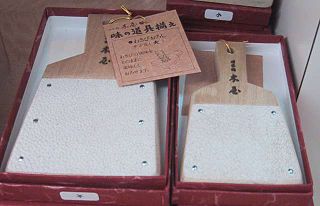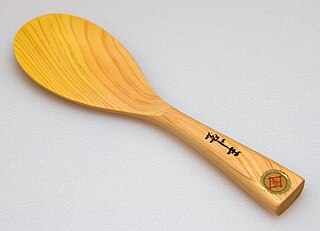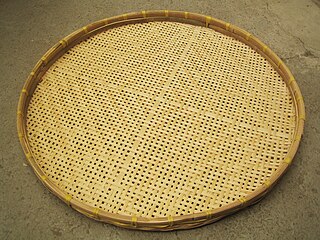 W
WAbura kiri (油きり) is a shallow tray used in the Japanese kitchen to place food on after deep frying. The shallow tray or pan has a rack and an absorbent paper towel to remove excess oil from the food after frying, as for example in tempura.
 W
WAmi jakushi (網杓子) is a skimmer used in the Japanese kitchen. The skimmer is made from a fine wire mesh and is used to remove small pieces of unwanted food or foam from a liquid. For example, in deep frying, the ami jakushi is used to remove small drops of batter during the frying of tempura. Another example would be the removal of foam from a miso soup to achieve a more pleasing aesthetic.
 W
WBamboo steamers, called zhēnglóng in Chinese, daenamoo jjimgi in Korean mushiki (蒸し器) or seiro (蒸籠) in Japanese, are vessels used for steaming in East Asian cuisine.
 W
WA wok is a round-bottomed cooking pot, originating in China. It is common in China and similar pans are found in parts of East, South and Southeast Asia, as well as becoming popular in other parts of the world.
 W
WA cleaver is a large knife that varies in its shape but usually resembles a rectangular-bladed hatchet. It is largely used as a kitchen or butcher knife intended for hacking through bone. The knife's broad side can also be used for crushing in food preparation.
 W
WDonabe are pots made out of a special clay for use over an open flame in Japanese cuisine, and in the case of semi-stoneware Banko ware of high petalite content. Often, the food is cooked at the table on a gas burner for various nabemono dishes such as shabu-shabu and dishes served simmering including nabeyaki udon. They are sized by sun, one of the Japanese units of measurement.
 W
WIn Japanese cuisine, a hangiri , also known as handai or sushi oke, is a round, flat-bottomed wooden tub or barrel used in the final steps of preparing rice for sushi. Traditional hangiri are made from cypress wood bound with two copper bands. They range in diameter from about 30 cm for use at home, to 1 meter for use in a restaurant.
 W
WA kamado is a traditional Japanese wood- or charcoal-fueled cook stove.
 W
WKatsuobushi kezuriki is a traditional Japanese kitchen utensil, similar to a wood plane or mandoline. It is used to shave katsuobushi, dried blocks of skipjack tuna (katsuo).
 W
WIn Japanese cooking, a makisu (巻き簾) is a mat woven from bamboo and cotton string that is used in food preparation. Makisu are most commonly used to make a kind of rolled sushi called makizushi (巻き寿司), but they are also used to shape other soft foods such as omelets, and to squeeze excess liquid out of food.
 W
WMakiyakinabe are square or rectangular cooking pans used to make Japanese-style rolled omelettes or tamagoyaki. The pans are commonly made from metals such as copper and tin, and can also be coated with a non-stick surface. Dimensions and proportions of the pan vary among regions of Japan, but it is always rectangular. Rolled omelettes made with makiyakinabe are commonly used as a side dish in sushi and bentō.
 W
WOroshigane , also known as oroshiki (下ろし器) are graters used in Japanese cooking.
 W
WAn oshizushihako is a box or mold used to make oshizushi. The box is traditionally made from wood, but nowadays often made from plastic. It can be disassembled into three parts: a bottom part, the rectangular walls, and a top part. Before use, the wooden box should be put in water to reduce sticking of the rice. The bottom and top parts can be covered with a layer of plastic foil for easier cleaning. The bottom part and the walls are assembled before the rice and the topping is added. Next, the top part is used to press down on the sushi, hence the name "pressed sushi". For disassembly, the rectangular walls are pulled up while the top part still presses against the sushi. After removing the top part, the sushi is cut and can be served.
 W
WOtoshi buta are Japanese-style drop-lids for use in Japanese cooking. These round lids float on top of the liquid in a pot while simmering foods. They ensure that the heat is evenly distributed and reduce the tendency of liquid to boil with large bubbles. This reduces the mechanical stress on the food and keeps fragile ingredients in their original shape.
 W
WA rice cooker or rice steamer is an automated kitchen appliance designed to boil or steam rice. It consists of a heat source, a cooking bowl, and a thermostat. The thermostat measures the temperature of the cooking bowl and controls the heat. Complex rice cookers may have sensors and other components, and may be multipurpose.
 W
WA shamoji or rice paddle is a large flat spoon used in East Asian cuisine. It is used to stir and to serve rice, and to mix vinegar into the rice for sushi.
 W
WSuribachi and Surikogi are a Japanese mortar and pestle. These mortars are used in Japanese cooking to crush different ingredients such as sesame seeds.
 W
WTakoyaki (たこ焼き or 蛸焼) or "octopus balls" is a ball-shaped Japanese snack or appetizer made of a wheat flour-based batter and cooked in a special molded pan. It is typically filled with minced or diced octopus (tako), tempura scraps (tenkasu), pickled ginger, and green onion (negi). The balls are brushed with takoyaki sauce and mayonnaise, and then sprinkled with green laver (aonori) and shavings of dried bonito (katsuobushi).
 W
WTetsubin (鉄瓶) are Japanese cast-iron kettles with a pouring spout, a lid, and a handle crossing over the top, used for boiling and pouring hot water for drinking purposes, such as for making tea.
 W
WA urokotori is a utensil used in Japanese cuisine to remove the scales from the skin of fish before cooking. Alternatively, it is possible to remove the scales with a knife, but this is more difficult and there is a higher risk of cutting the skin of the fish, especially with small fishes; knife-scaling also risks cutting one's own hand. The urokotori is pulled across the skin of the fish from the tail to the head repeatedly to remove the scales.
 W
WAn usu is a large Japanese stamp mill with a pestle called kine, used to pound rice or millet.
 W
WA zaru is a draining basket made from bamboo used in the preparation and presentation of Japanese cuisine. It can be used in a similar fashion to a sieve or colander, both of which are common in western cooking. Additionally, well-designed zaru are used to present food directly, as for example zarusoba. Plastic and metal versions of the zaru have also come into use, but are rarely used to present food.